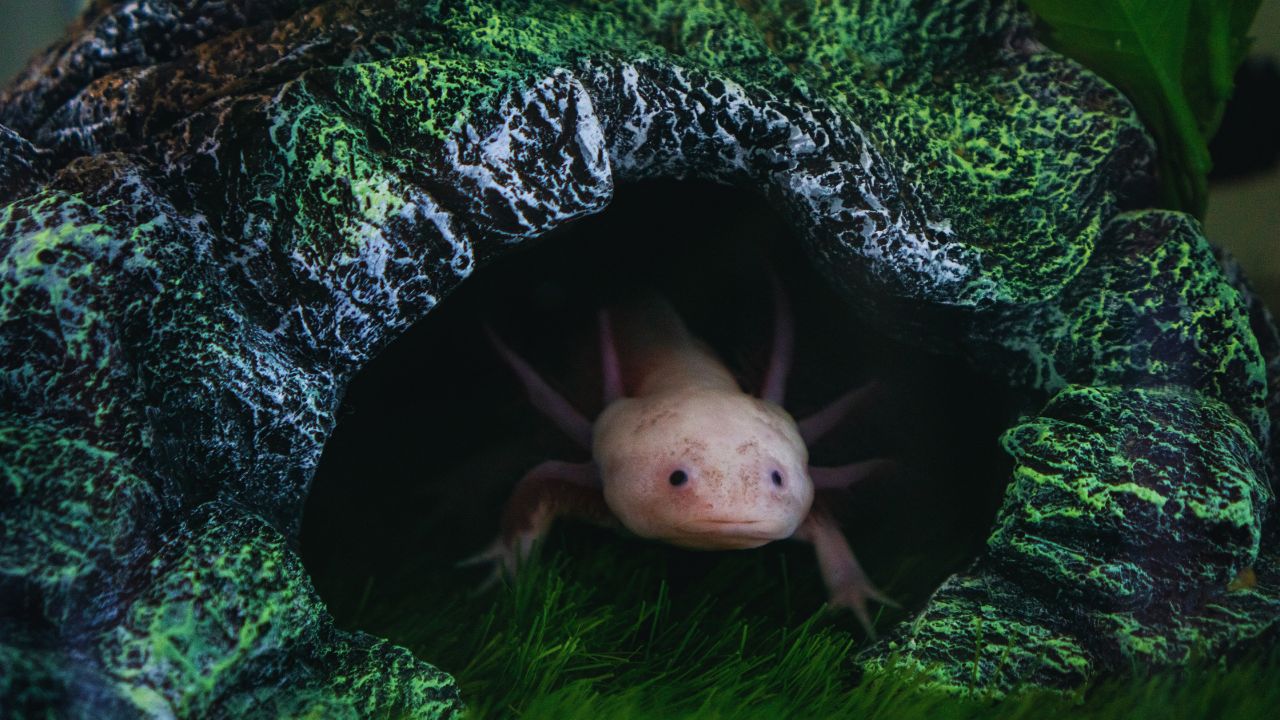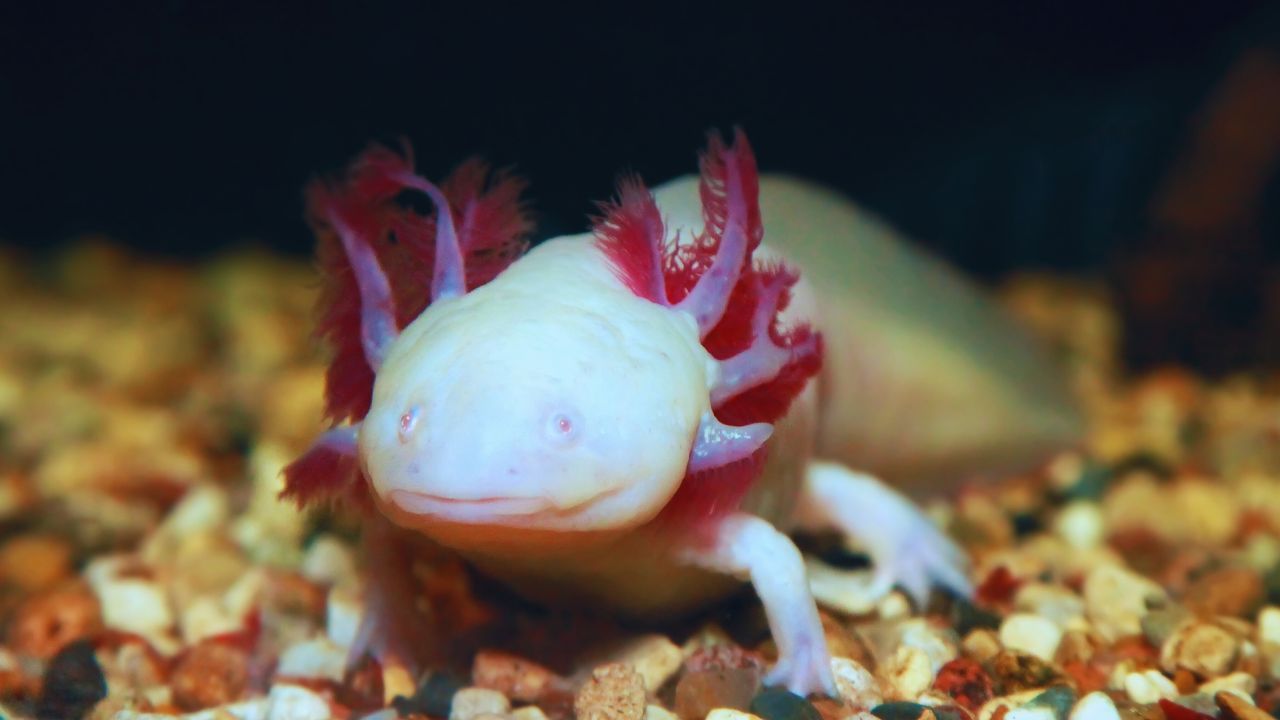Axolotls are the arrested Salamanders
Mistook for “Mexican walking fish,” axolotls are unusual amphibians that spend their whole lives underwater. Axolotls are renowned for having extraordinary regeneration powers; they can regenerate almost any part of their body, including internal organs, the spine, and even portions of their brains. Due to their unusual look, these intriguing animals are kept in zoos, breeding institutions, and labs in addition to being popular exotic pets. Sadly, there are very few of them in the wild.
Axolotls’ Regenerative Abilities

Some Notable Features The remarkable capacity of axolotls to regenerate almost any part of their body, including brains, spines, and limbs, is astounding. They are fascinating and a topic of scientific study because of their characteristic.
Neoteny: In contrast to other salamander species, axolotls are characterised by the persistence of their juvenile characteristics throughout their life. For example, they are unique among adult amphibians in that they have both gills and lungs.
Etymology: “Water monster” is the translation of the phrase “axolotl.” They are amphibians rather than fish, despite being referred to as “Mexican walking fish.”
Scientific Categorisations
| Category | Details |
|---|---|
| Scientific Classification | |
| Kingdom | Animalia |
| Phylum | Chordata |
| Class | Amphibia |
| Order | Caudata |
| Family | Ambystomatidae |
| Genus | Ambystoma |
| Scientific Name | Ambystoma mexicanum |
| Conservation Status | Endangered |
| Locations | |
| Central America | |
| North America |
Ambystoma mexicanum is the scientific name for the axolotl. This name’s etymology is up for discussion. Uncertainty surrounds whether Johann Jakob von Tschudi’s 1839 naming of the genus was meant to be “Amblystoma,” which translates to “blunt mouth” (from the Latin ambly, which means “dull,” and stoma, which means “mouth”). The term amystoma endures in spite of the ambiguity.

Look and Differences in Colour
Owing to genetic changes, axolotls display a variety of colours. The typical hue is olive-tan with flecks of gold. Additional differences consist of:
Leucistic: pale white or pink skin with black eyes.
Albino: Eyes and skin that match, both bright gold.
Axanthic: Eyes black, skin grey.
Melanoid: Completely black with no other hues.
To produce distinctive and eye-catching colour combinations for the pet market, breeders often cross-breed these varieties.

Physical attributes
Although they typically measure around 9 inches long, axolotls may reach up to 18 inches in length. Their weight may reach eight ounces. Their small, often-smiling lips and lidless eyes are features of their broad, flat heads. Axolotls carry their larval dorsal fin into adulthood and have three branching gills that extend from each side of their skulls. They have short, undeveloped limbs with long, thin digits that resemble fingers.
Axolotls are clearly sexually dimorphic. While females have bigger bodies to handle the 300–1,000 eggs they may carry at a time, males have massive, inflated cloacas and longer tails.
Qualities of Behaviour
Typically, axolotls are lone animals. They like to spend as little time as possible with people and are usually solitary creatures that hide in the underbrush and rocks of lakes. Their primary purpose in gathering is to mate.

Historical Evolution
Given that they have only been in their natural environment for around 10,000 years, axolotls are relatively young species in terms of evolution. In the 13th century, people started to live in their natural environment, and once Spain seized the area in the 1500s, urbanisation quickly increased. The axolotl’s original habitat was severely reduced as a result of the fast growth that gave rise to modern-day Mexico City.
Researchers have noticed that certain frogs only display certain characteristics during adolescence, such as underwater breathing in axolotls. This could be the result of their little evolutionary history prior to population decline.

Axolotl Facts
| Category | Details |
|---|---|
| Main Prey | Worms, Insects, and molluscs |
| Group Behaviour | Solitary |
| Distinctive Feature | Feathery gills and flattened-shaped head |
| Habitat | High-altitude freshwater lakes |
| Predators | Birds, Fish |
| Diet | Carnivore |
| Average Litter Size | 500 |
| Lifestyle | Solitary |
| Favourite Food | Worms |
| Type | Amphibian |
| Slogan | Found only in one complex of lakes! |
Environment
Axolotls are native to the Valley of Mexico, especially the area around Lake Xochimilco. They used to live beside Lake Chalco as well, but the region has been drained to stop floods, which has forced axolotls to move. Axolotls are entirely aquatic and thrive in water that is between 60 and 65 degrees Fahrenheit, despite belonging to the salamander family. Their favourite place to hide is in the lake’s bottom, where there are plants and rock formations.
Status of Population

According to the International Union for Conservation of Nature (IUCN), axolotls are in risk of becoming extinct in the wild and are classified as severely endangered. Due to Lake Xochimilco’s pollution and draining, Mexico City’s urban growth has had a detrimental effect on the population and resulted in a major loss of habitat.
The number of wild axolotls is estimated to be in the hundreds, a bleak estimate. Less than 30 axolotls per acre are found in their native environment, according to the most recent census. Their conservation status is complicated by the fact that they are heavily bred in captivity for food and pets.
Nutrition and Meal Patterns
As carnivores, axolotls consume molluscs, tiny fish, worms, crustaceans, insects, and insect larvae in their natural habitat. They usually eat salmon pellets, bloodworms, white worms, black worms, and daphnia when kept in captivity. For their pets’ health to be maintained, their diets must be high in protein.

Dangers and Predators
Predators of animals and humans both pose a hazard to axolotls. In certain civilisations, they are prized as delicacies, and many are caught and sold. The wild axolotl population has also suffered from the introduction of non-native species like Asian carp and African tilapia, since these fish compete with the axolotls for food and feed on their young.
Procreation and Duration of Life
Extending their lifetime to 25 years in captivity, axolotls may survive up to 15 years in the wild. Some may take up to 24 months to attain sexual maturity, although most do so around 18 months. They never fully change from their larval state.
Early spring or late winter is when axolotls breed. During their courting dance, which involves a chemical and visual signalling process, the male deposits sperm capsules that the female follows. During spawning, females often deposit 100–1,000 eggs on plants. Following a 14-day incubation period at 75 degrees Fahrenheit, the eggs hatch, and the larvae start eating within hours.
Axolotl parents don’t give a damn about their offspring and could even consume the eggs or young. Breeders and pet owners need to handle this with caution.
Axolotl Physical Characteristics
| Category | Details |
|---|---|
| Color | Brown, Grey, Black, White, and Pink |
| Skin Type | Permeable |
| Top Speed | 10 mph |
| Lifespan | 10 to 20 years |
| Weight | 60g–200g (2 oz–7 oz) |
| Length | 15 cm to 45 cm (6 in. to 18 in.) |
Pet Axolotls

Though they might be difficult for inexperienced pet owners, axolotls are a popular breed in the exotic pet trade. For the sake of their delicate skin, they need big water tanks with consistent temperatures. The average cost of buying an axolotl is $20 to $70; however, this price also covers tank installations, food, and possible veterinarian appointments. Owning an axolotl requires a substantial commitment due to their extended lifetime.
Zoos’ Axolotls
Exhibits of axolotls are found in many American zoos, where visitors may see these unusual animals and learn more about their conservation. The Detroit Zoo, San Diego Zoo, and Lincoln Park Zoo all have noteworthy exhibits.

Axolotl Varieties
While axolotls are an unmarried species of mole salamander, they display a wide range of genetic versions, resulting in diverse and exquisite colours. Breeders manipulate pigment cells, or chromatophores, to supply recognisable and specific specimens. New sorts are always being determined and bred. Some famous sorts of axolotls consist of:
- Wild Axolotl
- Leucistic Axolotl
- White Albino Axolotl
- Golden Albino Axolotl
- Melanoid Axolotl
- Axanthic-Axolotl Morph
- Copper Axolotl Morph
- GFP (Green Fluorescent Protein) Axolotl Morph
- Chimaera Axolotl Morph
- Mosaic Axolotl Morph
- Silver Dalmatian Axolotl Morph
- Enigma Axolotl Morph
- Firefly Axolotl, and Morph
FAQs (Frequently Asked Questions) about Axolotl
Can You Keep Axolotls as Pets?
Most people agree that axolotls make wonderful pets. Not only are these hardy animals cute, but they’re also interesting to watch and simple to take care of. They are a great option for novices since their care needs are low-maintenance and don’t need sophisticated routines or costly equipment. Furthermore, obtaining an axolotl is not too expensive.
Capable of Managing an axiolotl?
Axolotls may be handled gently, but it’s best not to hold them for longer than is absolutely required. It is best to avoid disturbing these amphibians and to handle them as little as possible.
Can You Remove Axolotls from the Water?
Since axolotls cannot breathe outside of water, prolonged immersion in it is not recommended. It is fine to temporarily remove them for duties like tank transfers, but they should spend as much time as possible in the water.
What is an axiolotl?
Tiger salamanders and axolotls are related species of amphibians. They display neoteny, which is the ability to reach maturity without going through a metamorphosis and to carry on with numerous juvenile characteristics into adulthood, such as dorsal fins and gills.
How Should ‘Axolotl’ Be Pronounced?
“Axolotl” should be pronounced axe-UH-lot-UHL.
How do axolotls feed? Do they prefer plants, meat, or both?
Since axolotls are carnivores, other animals make up their food.
Which Kingdom Are Axolotls a Part of?
Animalia is the kingdom that axolotls inhabit.
Which class are axolotls in?
Amphibia is the class to which axolotls belong.
Which Phylum Are Axolotls Included in?
Axolotls are members of the Chordata phylum.
Which Family Are Axolotls Part Of?
Members of the Ambystomatidae family include axolotls.
Which Order Are Axolotls in?
Axolotls are members of the Caudata order.
Which Genus Are Axolotls Included In?
Ambystoma is the genus to which axolotls belong.
What Kind of Clothes Do Axolotls Wear?
The skin of axolotls is porous.
What Kind of Environment Do Axolotls Occupy?
High-altitude freshwater lakes are home to axolotls.
What Is Axolotls’ Primary Prey?
The main food sources for axolotls include worms, insects, and molluscs.
Which animals prey on axolotls?
Fish and birds are the main predators of axolotls.
Which Axolotl characteristics set them apart?
The feathery gills and flattened skulls of axolotls are well-known features.
How Many Children Are Produced by Axolotls?
An axolotl may give birth to 500 children on average.
What Fascinating Axolotl Fact Is There?
Axolotls are unique to a single lake complex.
What is the axolotl’s scientific name?
Ambystoma mexicanum is the axolotl’s scientific name.
How long does an axolotl live?
Axolotls have a ten- to twenty-year lifespan.
Can an axolotl move quickly?
Axolotls have a maximum speed of ten miles per hour.
How Do Axolotls Start New Families?
Axolotls deposit eggs to procreate.





